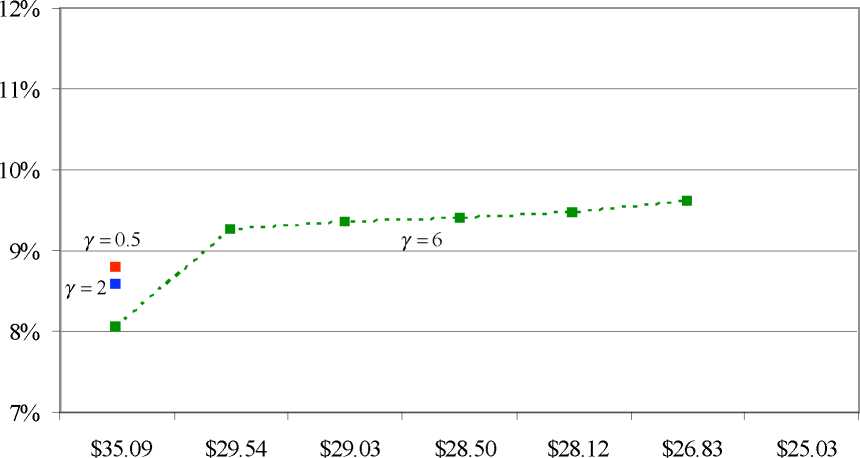Current Agriculture, Food & Resource Issues
M. Doyon, C. Brodeur and J-P. Gervais

Figure 3 Maximum discount rate of production quotas that entails no participation in the IEM
program for deliveries in May 2001 when average variable costs are $24 per hl.
profitable export contract is $28.12 per hl, the maximum annual discount rate ranges from
10.9 percent to 11.6 percent at an efficiency level of $16 per hl.
Figure 3 illustrates the trade-off between the discount rate of producers and export
prices if average variable costs are $24 per hl. Convergence of the grid search algorithm
fails when the second most profitable export contract in May 2001 is below $35.09 and
risk aversion is not high ( γ = 0.5 or 2). However, the maximum discount rate that entails
no participation in the IEM program ranges from 8.1 percent to 9.6 percent when producer
risk preferences entail a relative risk aversion coefficient of 6.
Simulations for May 2002
The second period used in the simulation of the portfolio model relates to export decisions
contracted in March 2002, a period of higher quota price, for deliveries occurring in May
2002. The volume of contracts offered to producers during that month was much lower
than a year earlier (9.1 million hl), but all contracts were accepted by producers.
Given the lower export prices for that period, the numerical model can only yield
valuable answers if the export price is sufficiently larger than the producers’ average
variable cost and/or the risk aversion coefficient is high. Figure 4 illustrates the maximum
discount rate of producers that does not entail participation in the IEM for the four
different export contract prices and risk aversion coefficients of 0.5, 2 and 6. A producer
who is strongly risk averse ( γ = 6 ) and produces at a constant marginal cost of $16 per hl
will not accept an export contract valued at $32 unless he/she discounts the production
quota at a rate of more than 9.3 percent. If the value of the export contract is lowered to
127
More intriguing information
1. A Dynamic Model of Conflict and Cooperation2. Tourism in Rural Areas and Regional Development Planning
3. The Trade Effects of MERCOSUR and The Andean Community on U.S. Cotton Exports to CBI countries
4. SOME ISSUES IN LAND TENURE, OWNERSHIP AND CONTROL IN DISPERSED VS. CONCENTRATED AGRICULTURE
5. Improvements in medical care and technology and reductions in traffic-related fatalities in Great Britain
6. The name is absent
7. The name is absent
8. The name is absent
9. Research Design, as Independent of Methods
10. Credit Market Competition and Capital Regulation